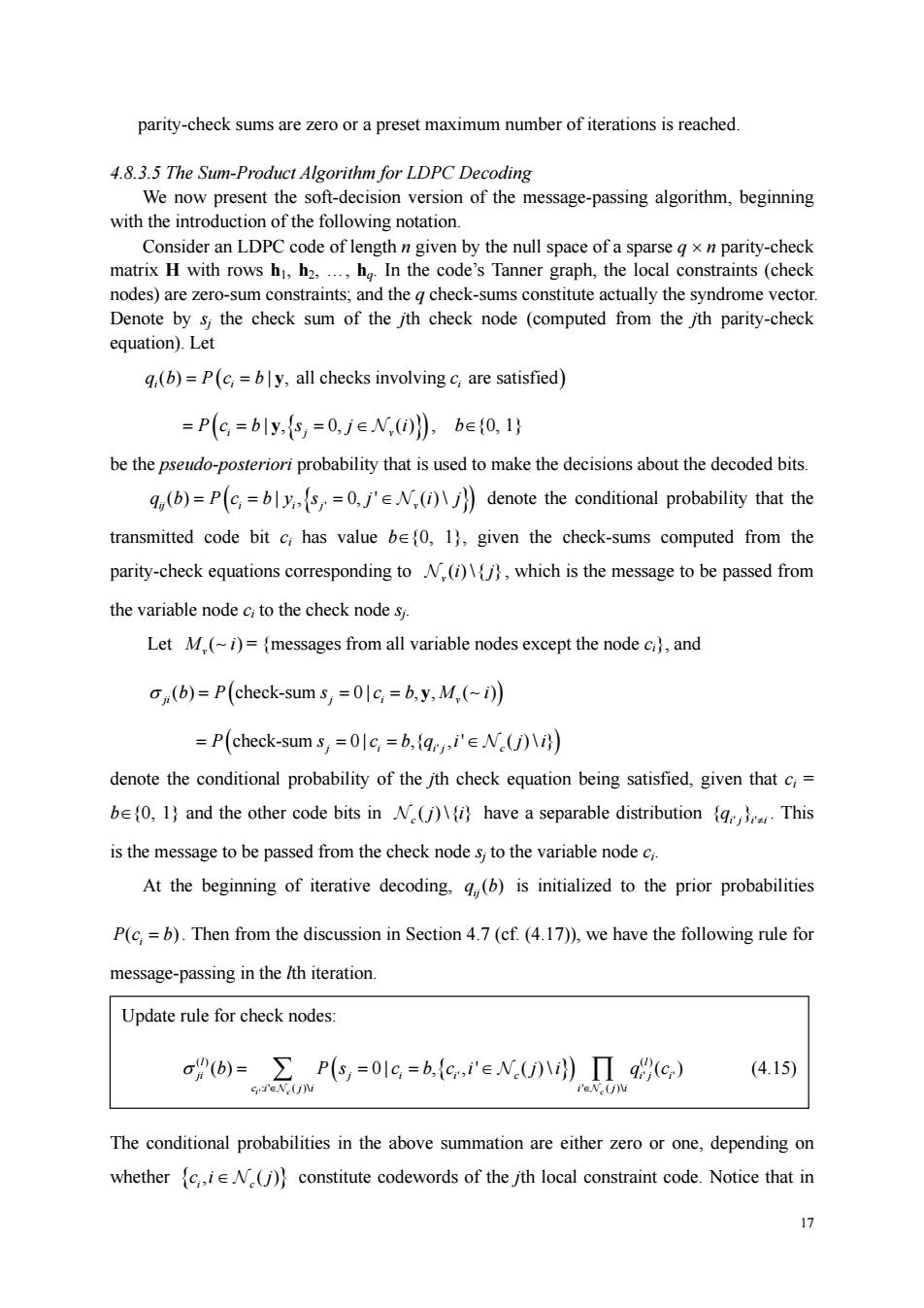正在加载图片...

parity-check sums are zero or a preset maximum number of iterations is reached. 4.8.3.5 The Sum-Product Algorithm for LDPC Decoding We now present the soft-decision version of the message-passing algorithm,beginning with the introduction of the following notation. Consider an ldpc code of length n given by the null space of a sparse a x n parity-check matrix H with rows h,h2 In the codes Tanner graph,the ocal onstraints (check nodes)are zero-sum nstraints; the check-sums constitute actually the syndrome v ect Denote by s the check sum of the /th check node (computed from the /th parity-check equation).Let q.(b)=P(c=bly,all checks involvingc,are satisfied) =P(c=bly,{s,=0,jeN()),be0,19 be the pseudo-posteriori probability that is used to make the decisions about the decoded bits. (b)=P(c=blys=0.j'.(i)denote the conditional probability that the transmitted code bit c has value be,1),given the check-sums computed from the parity-check equations corresponding to .()which is the message to be passed from the variable node c,to the check node s. Let M.(~i)=(messages from all variable nodes except the node c,and (b)=P(check-sums,=0lc,=b.y.M.(-i)) =P(check-sums,=0lc,=b,(qri'E N()\i) denote the conditional probability of the jth check equation being satisfied,given that c,= be 1)and the other code bits in .have a separable distributionThis is the message to be passed from the check node s,to the variable node c. At the beginning of iterative decoding.(b)is initialized to the prior probabilities P(c,=b).Then from the discussion in Section 4.7(cf.(4.17)).we have the following rule for message-passing in the /th iteration. Update rule for check nodes (6)-P(,-01c-b.feN()c) (4.15) SreN.(iM The conditional probabilities in the above summation are either zero or one,depending on whether ci()constitute codewords of the jth local constraint code.Notice that in 1717 parity-check sums are zero or a preset maximum number of iterations is reached. 4.8.3.5 The Sum-Product Algorithm for LDPC Decoding We now present the soft-decision version of the message-passing algorithm, beginning with the introduction of the following notation. Consider an LDPC code of length n given by the null space of a sparse q × n parity-check matrix H with rows h1, h2, ., hq. In the code’s Tanner graph, the local constraints (check nodes) are zero-sum constraints; and the q check-sums constitute actually the syndrome vector. Denote by sj the check sum of the jth check node (computed from the jth parity-check equation). Let ( ) | , all checks involving are satisfied ( ) ii i qb Pc b c = = y = = =∈ Pc b s j i ( ) ij v | , 0, ( ) y { N } , b∈{0, 1} be the pseudo-posteriori probability that is used to make the decisions about the decoded bits. q b Pc b y s j i j ij i i j v ( ) | , 0, ' ( ) \ = = =∈ ( ) { ' N } denote the conditional probability that the transmitted code bit ci has value b∈{0, 1}, given the check-sums computed from the parity-check equations corresponding to ( ) \{ } v N i j , which is the message to be passed from the variable node ci to the check node sj. Let ( ) Mv ∼ i = {messages from all variable nodes except the node ci}, and σ ji j i v ( ) check-sum 0 | , , ( ) b P s cbM i = == ( ) y ∼ ( ) ' check-sum 0 | ,{ , ' ( ) \ } = == ∈ P s c bq i j i j i ij c N denote the conditional probability of the jth check equation being satisfied, given that ci = b∈{0, 1} and the other code bits in ( ) \{ } c N j i have a separable distribution ' ' { } ij i i q ≠ . This is the message to be passed from the check node sj to the variable node ci. At the beginning of iterative decoding, ( ) ij q b is initialized to the prior probabilities ( ) Pc b i = . Then from the discussion in Section 4.7 (cf. (4.17)), we have the following rule for message-passing in the lth iteration. The conditional probabilities in the above summation are either zero or one, depending on whether {ci j i c , () ∈ N } constitute codewords of the jth local constraint code. Notice that in Update rule for check nodes: ( ) { } ' ( ) ( ) ' '' : ' ( )\ ' ( )\ ( ) 0| , , ' ( )\ ( ) i c c l l ji j i i c i j i ci ji i ji σ b Ps c b c i j i q c ∈ ∈ = == ∈ ∑ ∏ N N N (4.15)